Author: Arthur Hayes, founder of BitMEX; Translator: AIMan@Golden Finance
Equity investments shouted, “Stablecoins, stablecoins, stablecoins; Circle, Circle, Circle.”
Why are they so optimistic about them? Because U.S. Treasury Secretary Bessent said:
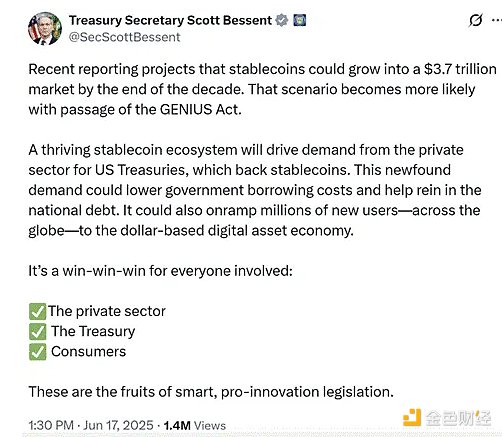 The result is shown in the figure below:
The result is shown in the figure below:

This is a comparison of the market value of Circle and Coinbase. Don’t forget, Circle has to give 50% of its net interest income to its big brother, Coinbase. How did Circle’s market cap get anywhere near 45% of Coinbase’s? It makes one wonder “hmm…”
Another result is this sad chart (because I own Bitcoin, not CRCL):
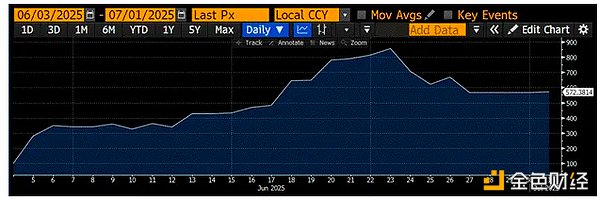
This is a chart of Circle’s price divided by Bitcoin’s price, with the index at the time of Circle’s IPO being 100. Since its IPO, Circle has outperformed Bitcoin by nearly 472%.
Crypto players should ask themselves: Why is US Treasury Secretary Bessent so optimistic about stablecoins? Why did the Genius Act gain bipartisan support? Is it because US politicians really care about financial freedom, or is there something else going on? Maybe politicians do care about financial freedom in theory, but lofty ideals don’t drive action. There must be more realistic political reasons behind Bessent’s U-turn on stablecoins. Remember that in 2019, Facebook’s efforts to integrate a stablecoin called Libra into its social media empire ultimately failed due to opposition from politicians and the Federal Reserve (Fed). Let’s review the main issues Bessent must solve to understand why Bessent is so obsessed with stablecoins.
The Problem Bessent Must Solve
The main problem facing US Treasury Secretary Bessent is the same as that faced by her predecessor, Janet Yellen. Their bosses like to spend money without raising taxes; the President of the United States and the politicians in the House and Senate. The Treasury Secretary then has to borrow at an affordable rate to finance the government. It soon became clear that the markets were unwilling to buy the long-term government bonds of any heavily indebted advanced economy at high prices/low yields. This is the doomsday image Bessent and Yellen have been watching for the past few years…booty booty butt:
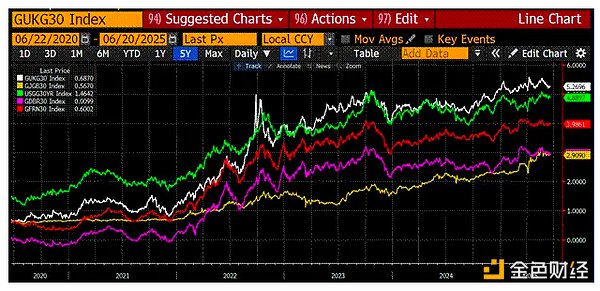 These are 30-year bond yields for the UK (white), Japan (gold), the US (green), Germany (magenta), and France (red).
These are 30-year bond yields for the UK (white), Japan (gold), the US (green), Germany (magenta), and France (red).
If rising yields weren’t bad enough, the actual value of these bonds has been burned.
Real value = Treasury bond price / gold price
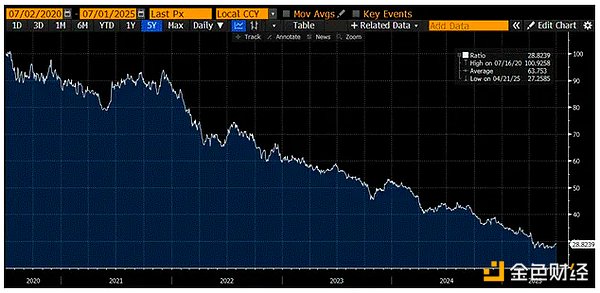 TLT US is an ETF that tracks US Treasury bonds with maturities of more than 20 years. The yield of TLT US is divided by the gold price and indexed to 100. Over the past five years, the real value of long-term US Treasury bonds has plummeted by 71%.
TLT US is an ETF that tracks US Treasury bonds with maturities of more than 20 years. The yield of TLT US is divided by the gold price and indexed to 100. Over the past five years, the real value of long-term US Treasury bonds has plummeted by 71%.
If past performance wasn’t bad enough, Yellen and Bessant now face other constraints. The Treasury’s bond sales team must come up with an issuance plan that can:
cover a roughly $2 trillion annual federal deficit and $3.1 trillion in debt maturing by 2025.
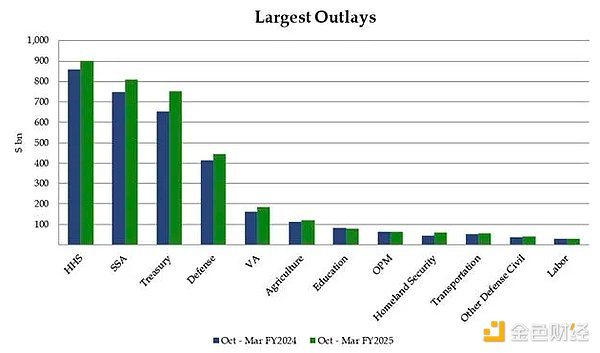
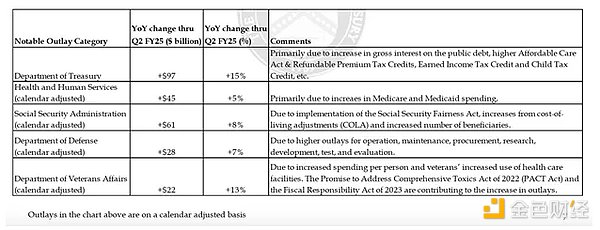 This chart from the U.S. Treasury Department details the largest U.S. federal government spending items and their year-over-year changes. Note that each of the major items grew at the same or faster rate than U.S. nominal GDP.
This chart from the U.S. Treasury Department details the largest U.S. federal government spending items and their year-over-year changes. Note that each of the major items grew at the same or faster rate than U.S. nominal GDP.
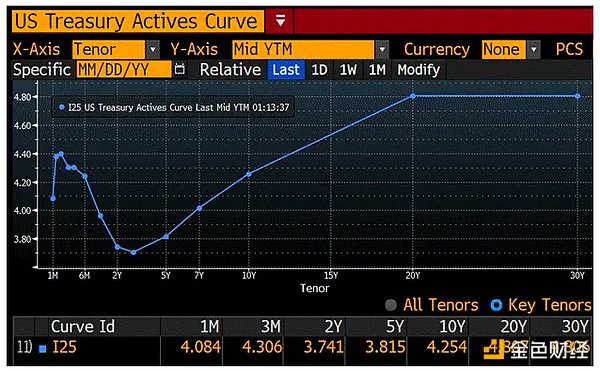
The first two charts show that the weighted average interest rate on outstanding Treasury bonds is lower than all points on the Treasury yield curve.
● The financial system issues credit against nominally risk-free Treasury bonds. Therefore, interest must be paid; otherwise, the government will nominally default, which will destroy the entire dirty fiat financial system. Because the entire Treasury yield curve is above the weighted average interest rate on current debt, the financing rate for maturing debt will be higher, so interest payments will continue to increase.
● Given the US involvement in Ukraine and the wars in the Middle East, the defense budget will not be reduced.
● Healthcare spending will increase in the early 2030s as baby boomers enter their prime years and receive treatment for diseases provided by big pharmaceutical companies funded by the US government.
Sell bonds in a way that the benchmark 10-year yield does not exceed 5%.
● When the 10-year Treasury yield approaches 5%, bond market volatility as measured by the MOVE index will soar, and a financial crisis will not be far away.
Sell Treasury bonds in a way that stimulates broader financial markets.
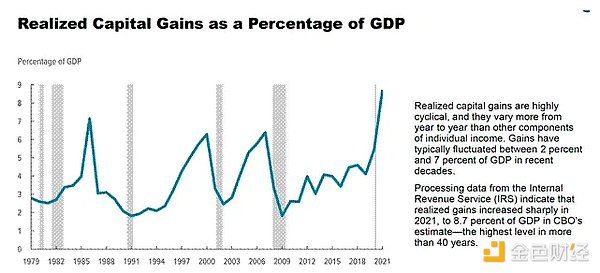 This chart from the Congressional Budget Office only includes data through 2021, but it clearly shows that capital gains tax revenue has soared as the US stock market has continued to rise after the 2008 global financial crisis.
This chart from the Congressional Budget Office only includes data through 2021, but it clearly shows that capital gains tax revenue has soared as the US stock market has continued to rise after the 2008 global financial crisis.
● The US government needs to collect revenue from taxing the stock market's year-over-year gains to prevent a truly unbelievably large fiscal deficit.
● The US government exists to serve wealthy property owners. In the good old days, maids were in the kitchens, niggers were in the fields, Indians were in the outback, and only white male property owners were allowed to vote. In modern America, while suffrage is universal, power still comes from controlling the wealth of public companies, leading to government policies that nourish and consolidate the power of about 10% of households, which control more than 90% of stock market wealth. One of the most striking examples of government favoritism for the rich was during the 2008 global financial crisis, the Fed printed money to save the banks and the broader financial system, but the banks were still allowed to foreclose on people's homes and businesses. Socialism for the rich, capitalism for the poor! With a record like that, it's no wonder New York mayoral candidate Mamdani is so popular; The poor want some socialism, too.
The Treasury Secretary has an easy job when the Fed engages in quantitative easing. The Fed prints money and buys bonds, which allows the US government to issue a large amount of cheap bonds and boost the stock market. But now that the Fed must at least ostensibly appear to be fighting inflation, the august institution cannot cut rates or engage in quantitative easing. The Treasury must do the heavy lifting alone.
By September 2022, the market decided to sell bonds on margin, in the belief that the largest peacetime federal deficit in U.S. history would persist and the Fed was hawkish. The 10-year Treasury yield had nearly doubled in two months, stocks had fallen nearly 20% from their summer highs, and then Yellen put on her red bottoms and got to work. In a paper written by Hudson Bay Capital, Yellen was called an aggressive Treasury issuer (ATI), and she began issuing more Treasury bonds than coupon-bearing bonds. Over the next two years, $2.5 trillion was pumped into financial markets as the Fed’s reverse repo program (RRP) balances fell. If the goal was to check the three boxes I outlined above, Yellen’s ATI policy crushed it.
That was then, but what about Bessent?
What about Bessent
How will he check the same boxes in the current environment? RRP is virtually empty; where will he find the trillions of dollars of offsets on his balance sheet ready to buy Treasuries at high prices and low yields?
The third quarter of 2022 was uneventful. The chart below of the Nasdaq 100 (green) and the 10-year Treasury yield (white) shows how stocks have plummeted as yields have soared.
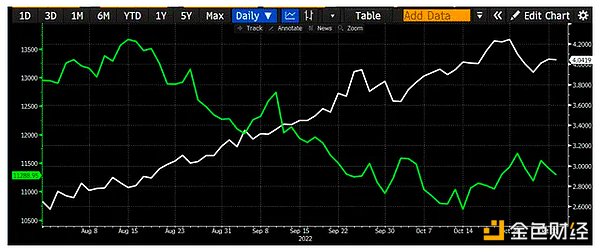
ATI policy effectively lowered RRP (red) and pushed up financial assets such as the Nasdaq 100 Index (green) and Bitcoin (magenta). The 10-year US Treasury yield (white) has never broken through 5%.
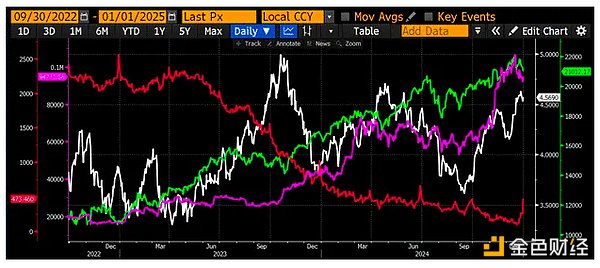
The large "too big to fail" (TBTF) banks have two pools of funds,which are ready to buy trillions of dollars worth of US Treasuries as long as the necessary profit potential exists. The two pools are demand/time deposits and reserves held at the Federal Reserve. The reason I focus on these eight "too big to fail" banks is that their existence and profitability depend on the government guarantee of their debts, and the banking regulations are designed to benefit them more than non-"too big to fail" banks. Therefore, as long as there is some profit to be made, they will follow the government's instructions. Bessent requires them to buy its low-quality bonds, and in return Bessent will provide them with a risk-free return.
I think the reason US Treasury SecretaryBessent is so enthusiastic about "stablecoins" is that by issuing stablecoins, TBTF banks will release up to $6.8 trillion in purchasing power of Treasury bonds. These inactive deposits can then be re-used in the unstable fiat financial system, boosting markets. In the next section, I will lay out my model of how stablecoin issuance can facilitate Treasury purchases and boost profitability for TBTF banks.
After discussing stablecoin-to-Treasury liquidity, I will quickly explain that if the Fed stopped paying interest on reserves, it would free up up to $3.3 trillion to purchase Treasuries. This would be another example of something that is not strictly quantitative easing, but it would have the same positive impact on fixed supply monetary assets like Bitcoin.
Let’s take a look at Bessent’s new favorite monetary bazooka – stablecoins.
Liquidity Analysis: How much purchasing power will Bessent's new favorite "stablecoin" bring to Treasury bonds
My forecast is based on several key assumptions:
Treasuries are fully or partially exempted from the supplementary leverage ratio (SLR)
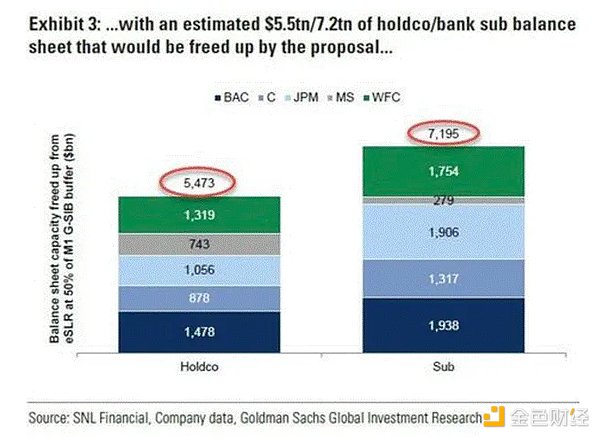
The exemption means that banks do not need to hold equity in their Treasury bond portfolios. Full exemption means that banks can purchase Treasury bonds with unlimited leverage.
The Federal Reserve has just voted to reduce the capital requirements for banks holding U.S. Treasury bonds; the initial effects will be seen in the next three to six months. It is estimated that the proposal would free up $5.5 trillion in bank balance sheet capacity to buy U.S. Treasuries, as shown in the chart above. Markets are forward-looking, so these purchases will begin to lead in the Treasury market, causing yields to fall (other things being equal).
Banks are profit-oriented, loss-minimizing organizations
● From 2020 to 2022, the Fed and Treasury urged banks to increase their holdings of U.S. Treasuries; banks purchased large amounts of long-term coupon bonds due to higher yields. By April 2023, losses on these bonds caused three banks to fail in a week due to the Fed’s fastest policy rate increase since the early 1980s. In the “too big to fail” realm, Bank of America’s losses on its held-to-maturity bond portfolio exceeded its total equity, and the bank would fail if forced to mark its bond portfolio to market. To quell the crisis, the Fed and Treasury effectively nationalized the entire U.S. banking system through the Bank Term Funding Program (BTFP). However, non-too-big-to-fail banks can still lose money, and if losses on Treasury bonds lead to bankruptcy, management will be removed and the bank will be sold at a low price to Jamie Dimon or other "too big to fail" banks. Therefore, bank chief investment officers are reluctant to increase their holdings of long-term Treasury bonds, fearing that the Fed will raise interest rates again.
● Banks will buy Treasury bonds because they are actually high-yielding zero-duration cash-like instruments.
● Banks will only buy Treasury bonds with deposits if they earn a high net interest margin (NIM) and pay no or only a small amount of capital.
JP Morgan recently announced plans to launch a stablecoin called JPMD. JPMD will be based on Base, an Ethereum-based Layer 2 system operated by Coinbase. Therefore, JP Morgan will have two types of deposits. The first type I will call time deposits. Time deposits are still digital, but moving them around the financial system requires an outdated system of banks communicating with each other, as well as a lot of manual oversight. Time deposits can be transferred between 9am and 4:30pm, Monday through Friday. Time deposits offer very little yield; the FDIC estimates that the average yield on demand deposits is 0.07% and the average yield on a one-year time deposit is 1.62%.
The second type of deposit is a stablecoin, or JPMD for short. JPMD is based on the public blockchain Base. Customers can use their JPMD 24/7, 365 days a year. By law, JPMD cannot pay out earnings, but I imagine JPMorgan Chase will entice customers to convert their time deposits into JPMDs by offering generous cash back consumer offers. It is not clear whether offering staking earnings is allowed.
Staking yield: When customers lock their JPMD with JPMorgan, the stablecoin earns a yield during the lockup period.
Bank deposits will flow to stablecoins
Customers move funds from time deposits to JPMD because JPMD is more useful and the bank offers cash back spending benefits. Overall, TBTF banks have an estimated total of $6.8 trillion in demand and time deposits. Since stablecoins are a superior product, time deposits will soon be converted to JPMD or similar stablecoins issued by other TBTF banks.
Why is JPMorgan going to so much trouble to persuade customers to switch from time deposits to JPMD? First, to reduce costs. If all time deposits were converted to JPMD, JPMorgan could effectively eliminate its compliance and operations departments. Let me explain why Jamie Dimon was flabbergasted when he learned how stablecoins work.
High-level compliance consists of a set of rules promulgated by regulators and enforced by a group of people using technology from the early 1990s. Rules are structured in the form of: if this happens, do this. These "if/then" relationships can be interpreted by a senior compliance officer and codified into rules that an AI agent can perfectly follow. Since all public addresses are public, JPMD provides full transparency, so an AI agent trained on a corpus of relevant compliance regulations can perfectly ensure that certain transactions will never be approved. The AI can also prepare any reports required by regulators on the fly. In turn, regulators can verify the correctness of the data because all data exists on a public blockchain. Overall, TBTF banks spend a total of $20 billion per year on compliance and the operations and technology required to comply with banking regulations. By converting all time deposits to stablecoins, this cost will effectively be reduced to zero.
The second reason JPMorgan is pushing JPMD is that it allows the bank to risk-free buy billions of dollars worth of US Treasuries using its custodial stablecoin assets (AUC). This is because US Treasuries have near zero interest rate risk, yet actually generate the Fed Funds rate. Remember, under the new SLR policy, the TBTF banks have $5.5 trillion of Treasury buying power. The banks need to find a pool of inert cash to buy said debt, and deposits held in their stablecoins are the perfect place to do that.
Some readers might counter that JPMorgan can already buy US Treasuries with its time deposits. My response is that stablecoins are the future because they create a better customer experience and help the “too big to fail” bank save $20 billion in costs. This cost savings alone should incentivize banks to embrace stablecoins; the additional net interest margin is icing on the cake.
I know many readers are tempted to throw their hard-earned cash into Circle (CRCL) or the next shiny new stablecoin issuer. But don’t overlook the earnings potential of stablecoins for TBTF banks. If we take the average TBTF bank P/E of 14.41x and multiply it by the cost savings and net interest margin potential of stablecoins, the result comes to $3.91 trillion. The current market cap of the eight TBTF banks is about $2.1 trillion, which means that stablecoins could drive TBTF bank stock prices up 184% on average. If there is one non-consensus trade that investors can execute at scale, it is to go long an equally weighted basket of TBTF bank stocks based on this stablecoin thesis.
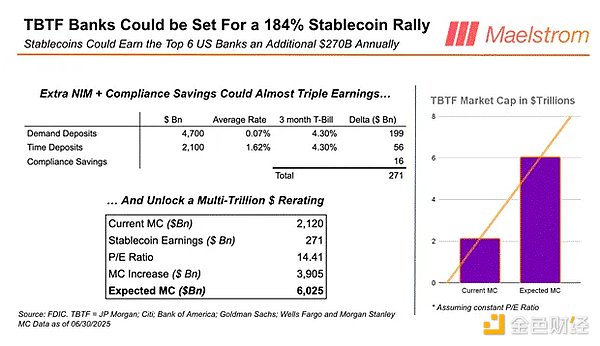 What about competition?
What about competition?
Don’t worry; The Genius Act ensures that non-bank-issued stablecoins cannot compete on a large scale. The act explicitly prohibits tech companies like Meta from issuing their own stablecoins; they must partner with a bank or fintech company. Of course, in theory anyone can get a banking license or acquire an existing bank, but all new owners must be approved by regulators. Let’s wait and see how long this takes. Another provision that cedes the stablecoin market to banks is a ban on paying interest to stablecoin holders. Unable to compete with banks on interest payments, fintechs will not be able to siphon deposits from banks at affordable rates. Even a successful issuer like Circle will never be able to tap into the $6.8 trillion of time deposits held by “too big to fail” (TBTF) banks. Furthermore, fintechs like Circle and small banks do not enjoy a government guarantee on their debt, but “too big to fail” banks do. If my mother were to use a stablecoin, it would have to be issued by a “too big to fail” bank. Baby boomers like her would never use a fintech bank or a small bank for that purpose because they don’t trust them due to the lack of a government guarantee.
David Sacks, President Trump’s “crypto tsar,” agrees. I’m sure many corporate crypto donors are irritated that they’ve donated so much to crypto campaigns only to be quietly shut out of the lucrative US stablecoin market. Perhaps they should change tack and truly advocate for true financial freedom, rather than just trying to find a stool under the chamber pots of too-big-to-fail bank CEOs.
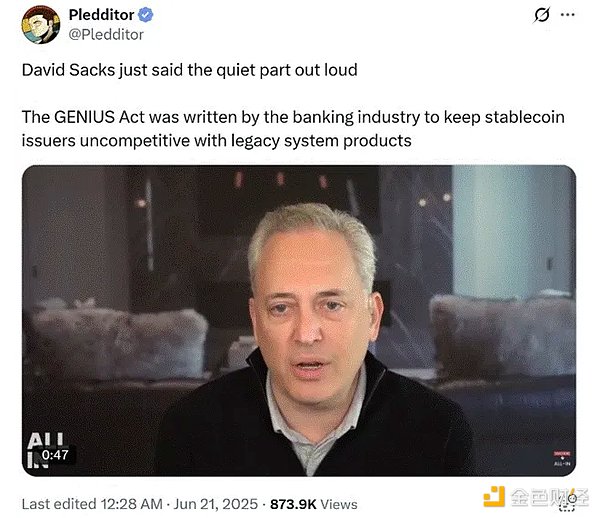
In short, the "too big to fail" banks adopt stablecoins, eliminating fintech competition for their deposit base, reducing the need for high-cost manpower and often incompetent compliance personnel, and not having to pay interest, thereby improving net interest margins, ultimately causing their stock prices to soar. In return for Besent's gift of stablecoins, the "too big to fail" banks will buy up to $6.8 trillion worth of US Treasuries.
What else can the Fed release
ATI: Yellen: Stablecoins: Bessent
Next, I will discuss how Bessent can release another $3.3 trillion of inert reserves from the Fed's balance sheet.
Interest on Reserve Balances (IORB)
After the 2008 global financial crisis, the Fed decided that banks would never fail due to a lack of reserves. The Fed created some idle reserves on its balance sheet by purchasing U.S. Treasury bonds and mortgage-backed securities from banks; this is called quantitative easing. In theory, banks could convert reserves deposited with the Fed into circulating currency and then lend them out, but because the Fed would print money to pay enough interest, banks refused to do so. The Fed sterilized these reserves to prevent inflation from surging further. The problem for the Fed is that as interest rates rise, so does the interest on reserve balances (IORB). This is not a good thing because the unrealized losses on the Fed's bond portfolio also increase as interest rates rise. As a result, the Fed is insolvent and has negative cash flow. However, negative cash flow conditions are purely a policy choice and can be changed.
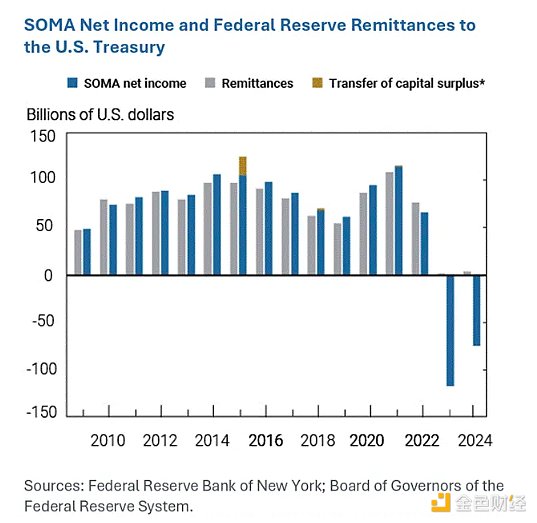
U.S. Senator Ted Cruz recently mused that perhaps the Fed should stop paying IORB. This would force banks to make up for the lost interest income by converting reserves into Treasuries. Specifically, I think they would buy Treasuries because of their high-yielding, cash-like properties.
Senator Ted Cruz has been urging his Senate colleagues to end the authority to pay banks interest on reserves because he believes the change would contribute greatly to lowering the deficit. – Source: Reuters
Why is the Fed printing money to stop banks from propping up this empire? There is no reason for politicians to oppose this policy change. Democrats and Republicans love fiscal deficits; why not increase spending by unleashing $3.3 trillion of bank buying power into the Treasury market? Given the Fed’s reluctance to help Team Trump fund America First, I believe Republican lawmakers will use their majorities in both chambers to strip the Fed of this power. So the next time yields spike, lawmakers will be ready to unleash this flood of money to fund their profligate spending.
Before concluding this article with my optimism about the dollar liquidity that will surely be created during Bessent’s term, I want to talk about Maelstrom’s cautious positioning from now until the third quarter.
Cautionary Tale
While I am extremely optimistic, I believe there may be a brief lull in dollar liquidity creation after the passage of Trump’s spending bill, known as the “Big Beautiful Bill”.
The bill as it stands raises the debt ceiling. While politicians will haggle over many of the provisions, Trump will not sign a bill that does not raise the debt ceiling. He needs additional borrowing capacity to fund his agenda. There is no sign that Republicans will try to force the government to cut spending. The question for traders is how will dollar liquidity be affected when the Treasury resumes net borrowing?
As of January 1, the Treasury has continued to fund the government primarily by drawing funds from its checking account, the Treasury General Account (TGA). As of June 25, the TGA balance was $364 billion. According to the Treasury's guidance in its latest quarterly refunding announcement, if the debt ceiling were raised today, the TGA balance would be replenished to $850 billion through bond issuance. This would result in a $486 billion contraction in dollar liquidity. The only major dollar liquidity item that could mitigate the negative shock is the outflow of funds from the RRP account (currently $461 billion).
This is not a sure-fire short-term Bitcoin trade due to the TGA replenishment. This is a cautious play; the bull run could be interrupted in short order. I think the market will trade sideways to slightly lower between now and Jerome Powell’s speech at the Jackson Hole Fed in August. If the TGA replenishment proves to be a negative for USD liquidity, the downside is between $90,000 and $95,000. If the replenishment proves to be meaningless, Bitcoin will hover around $100,000 and not break the all-time high of $112,000. I have a feeling Powell will announce an end to quantitative tightening and/or other seemingly mundane but significant bank regulatory reforms. By early September, the debt ceiling will be raised, the TGA will be largely replenished, and the Republicans will focus on distributing benefits so they don’t get hit by Mamdani in this district in November 2026. At that point, the green cross (K-line) will pierce the bears driven by a surge in money issuance.
From now until the end of August, Maelstrom will be adding USDe (Ethena USD). We have sold all of our illiquid shitcoin positions. Depending on price action, we may also reduce our Bitcoin positions. Maelstrom bought shitcoins around April 9 and made 2x to 4x returns on some of them in three months. Without a clear liquidity catalyst, the shitcoin system will be completely destroyed. After that, we can confidently rummage through the box and perhaps make 5x or 10x returns before fiat liquidity creation stalls again in late Q4 2025 or early Q1 2026.
Check the box
Too big to fail banks adopting stablecoins could create up to $6.8 trillion in Treasury purchasing power.
The Fed stopping IORB payments would create up to $3.3 trillion in Treasury purchasing power.
$10.1 trillion could potentially flow into the Treasury market over time as a result of Bessent’s policies. If my predictions are correct, this $10.1 trillion liquidity injection will do for risk assets what Yellen’s $2.5 trillion injection did… SUDDENLY!
This is another liquidity arrow that could be pulled from Besent’s policy quiver if necessary. This arrow could come in handy once Trump’s Big Beautiful Act passes and the debt ceiling is raised. Soon, investors will start to worry about how the Treasury market will absorb such a huge amount of outstanding bonds without collapsing.

Some of you are still waiting for Monetary Godot. You are waiting for Fed Chairman Powell to announce another round of unlimited quantitative easing and rate cuts before you sell bonds and buy cryptocurrencies. This is not going to happen, at least not until the United States is sure to have a kinetic war with Russia, China and/or Iran, or a large systemically important financial institution is on the verge of collapse. Not even a recession can bring Godot. So stop listening to the fool in the green hat chair (FED Chairman Powell) and start listening to the man waving a giant dick (Treasury Secretary Bessent).
What follows will show the opportunity cost that investors suffer while waiting for Monetary Godot.
The Fed’s balance sheet (white) fell while the effective fed funds rate (gold) rose. You might think that Bitcoin and other risk assets would have plummeted during this period.
Yellen didn’t want to disappoint the rich and did an ATI. Bitcoin (gold) rose more than 5x while RRP balances fell 95%.
Don’t make the same mistake again. Many financial advisors are still persuading clients to buy Treasuries because yields are expected to fall (meaning bond prices will rise). I agree that central banks around the world will cut rates and print money to prevent their government bond markets from collapsing. Moreover, if central banks don’t act, national treasuries will. This is the argument I make in this article; I believe that Bessent can unlock up to $10.1 trillion in Treasury buying power by supporting stablecoin regulation, SLR exemptions, and stopping IORB payments. But who cares if you get 5% or 10% on a long bond? You’ll miss out on Bitcoin rising 10x to $1 million or the Nasdaq 100 surging 5x to 100,000 by 2028.
The real stablecoin strategy isn’t betting on old-school fintechs like Circle — it’s understanding that the U.S. government just handed the firing keys to a multi-trillion dollar bazooka of liquidity disguised as “innovation” to “bad” banks.This isn’t DeFi, and it isn’t financial freedom. This is the monetization of U.S. Treasuries in Ethereum’s guise.If you’re still waiting for Powell to whisper “unlimited QE” in your ear before taking the plunge, congratulations — you’re the one exiting liquidity.
Better be long Bitcoin. Be long JPMorgan. Forget Circle. The Trojan horse of stablecoins has made its way into the fortress, and once it’s opened, it’s no libertarian fantasy — it’s flooded with liquidity to buy Treasuries, designed to keep the stock market inflated, the deficit covered, and the baby boomers appeased. Don’t sit back and wait for Powell to bless the bull market. Bessent has had enough fun, it’s time for him to conquer the world with his liquidity juice.
 Joy
Joy

 The result is shown in the figure below:
The result is shown in the figure below:

 These are 30-year bond yields for the UK (white), Japan (gold), the US (green), Germany (magenta), and France (red).
These are 30-year bond yields for the UK (white), Japan (gold), the US (green), Germany (magenta), and France (red). TLT US is an ETF that tracks US Treasury bonds with maturities of more than 20 years. The yield of TLT US is divided by the gold price and indexed to 100.
TLT US is an ETF that tracks US Treasury bonds with maturities of more than 20 years. The yield of TLT US is divided by the gold price and indexed to 100. 
 This chart from the U.S. Treasury Department details the largest U.S. federal government spending items and their year-over-year changes. Note that each of the major items grew at the same or faster rate than U.S. nominal GDP.
This chart from the U.S. Treasury Department details the largest U.S. federal government spending items and their year-over-year changes. Note that each of the major items grew at the same or faster rate than U.S. nominal GDP. 
 This chart from the Congressional Budget Office only includes data through 2021, but it clearly shows that capital gains tax revenue has soared as the US stock market has continued to rise after the 2008 global financial crisis.
This chart from the Congressional Budget Office only includes data through 2021, but it clearly shows that capital gains tax revenue has soared as the US stock market has continued to rise after the 2008 global financial crisis.


 What about competition?
What about competition? 






